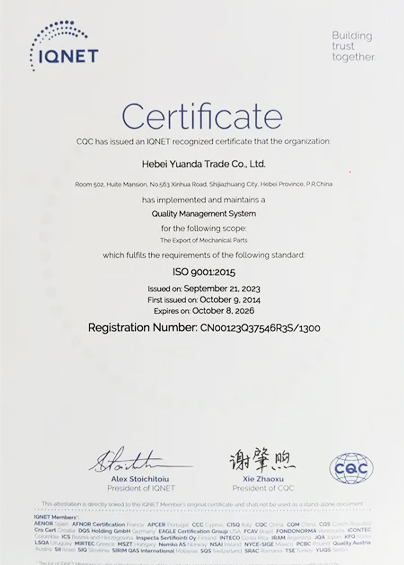Mobile:+86-311-808-126-83
Email:info@ydcastings.com
French
100mm end cap
Understanding 100mm End Caps A Comprehensive Overview
In the world of piping, plumbing, and various fluid transfer systems, certain fittings play crucial roles in maintaining the integrity and functionality of a system. One such essential component is the end cap, specifically the 100mm end cap. This article will delve into what 100mm end caps are, their applications, benefits, installation processes, and considerations for selection.
What is a 100mm End Cap?
A 100mm end cap is a fitting used to close the end of a pipe or tube that has a nominal diameter of 100 millimeters. These caps are typically manufactured from various materials, including PVC (Polyvinyl Chloride), metal, and polyethylene, making them suitable for different environments and applications. The fundamental purpose of an end cap is to seal the opening of the pipe, preventing the escape of fluids or gases, thus maintaining system pressure and efficiency.
Applications of 100mm End Caps
100mm end caps are versatile and used across numerous industries. Some common applications include
1. Plumbing Systems In residential and commercial plumbing, these end caps help seal water supply lines, ensuring no leaks occur at the ends of pipes. 2. HVAC Systems End caps play a significant role in heating, ventilation, and air conditioning systems by sealing ducts to maintain airflow and system efficiency. 3. Industrial Processes Many manufacturing processes require the use of pipes to transport materials. 100mm end caps can help close off these pipes to prevent contamination or spills. 4. Irrigation Systems In agricultural applications, these caps can seal irrigation pipes to ensure consistent water flow and prevent waste.
Benefits of Using 100mm End Caps
The use of 100mm end caps offers several advantages
100mm end cap

- Leak Prevention End caps effectively prevent leaks and spills, ensuring that the system operates efficiently without loss of fluids. - Durability Depending on the material chosen, end caps are designed to withstand various environmental conditions, from extreme temperatures to corrosive substances. - Cost-Effectiveness By preventing leaks and maintaining system integrity, end caps help to reduce maintenance costs over time. - Ease of Installation End caps are straightforward to install, often requiring minimal tools and equipment, which saves time and labor costs.
Installation Process
Installing a 100mm end cap is usually a simple process. Here’s a step-by-step guide
1. Select the Right Material Choose the end cap material based on your application. For example, PVC is suitable for water systems, while metal caps may be required for industrial applications. 2. Prepare the Pipe Ensure the end of the pipe is clean and free of debris. If necessary, cut the pipe to the desired length and clean the edge. 3. Apply Adhesive (if applicable) If you are using a solvent weld cap, apply the appropriate adhesive or solvent to both the pipe end and the inside of the cap. 4. Attach the End Cap Place the end cap over the pipe end and ensure it's secured firmly in place. For threaded caps, twist it onto the pipe until snug. 5. Allow for Curing If adhesives were used, allow the recommended curing time before applying pressure to the sealed system.
Considerations for Selection
When choosing a 100mm end cap, it’s essential to consider several factors
- Material Compatibility Match the end cap material with the pipe material to prevent issues such as corrosion and failure. - Pressure Ratings Ensure that the end cap you select can handle the system's operating pressures and temperatures. - Environment Consider the environmental conditions the end cap will be exposed to, including chemicals, moisture, and temperature fluctuations.
Conclusion
In conclusion, 100mm end caps are vital components in various piping systems. Their ability to seal and protect the integrity of pipes makes them invaluable across multiple industries, from plumbing to industrial processes. By understanding their applications, benefits, and installation procedures, professionals can ensure effective and efficient solutions in their respective fields, ultimately contributing to enhanced system performance and reliability. Selecting the right end cap is crucial in maintaining a leak-free and efficient fluid transfer system, underscoring the importance of this seemingly simple yet powerful fitting in engineering and construction.











